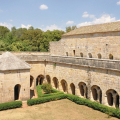Cistercian abbey, with a Romanesque church and remarkable cloisters, in Le Thoronet, the most visited site in the Var.
The abbey of Thoronet is the most visited site in the Var. It forms with the two other Cistercian abbeys of Provence, Sénanque and Silvacane, this trilogy to which the pretty name of "our three little Provençal sisters" has been awarded. It was in 1146 that monks who came from Tourtour to find water discovered this site. The rule of St. Benedict required them to live in a state of humility, poverty and balance between work and prayer. The Cistercians sought silence, worked with their hands, cultivated the vine and the olive tree. From the 14th century on, the rules became more lax. The number of monks decreased. During the Revolution, they were expelled and the abbey was abandoned. It was used as a stone quarry by the villagers who came to get materials to build their houses. Prosper Mérimée saves the abbey by reporting it to the architect of the Monuments Historiques. The decline was halted and the restoration began. Some buildings had completely disappeared - the kitchen, the scriptorium, the monks' refectory. Fortunately, a large part of the rooms are still intact, and visiting them gives curious visitors a glimpse of the monks' daily life:
The church. Romanesque in style and built with local limestone, it has a sober facade and a state of simplicity in keeping with the Cistercians' quest for austerity. It is in the shape of a Latin cross and has a nave with four bays. Of modest size, with its 40 m length and 20 m width, the nave is covered with barrel vaults (or half barrel vaults at the level of the aisles).
The cloister. It is one of the oldest Cistercian cloisters still intact, its construction being estimated at 1145. It constitutes the heart of the monastic complex and connects the different buildings to each other. Its four galleries frame a garden whose calm is conducive to meditation and prayer. The arcades of the south gallery are characteristic of Cistercian Romanesque art, while those of the north gallery have capitals decorated with water leaves and hooks, typical of the Gothic period. Near the north gallery, in the inner garden of the cloister, there is a small pavilion dedicated to the monks' toilet. The lavatorium, a hexagonal stone basin fed by sixteen spouts, was used for the monks' ablutions.
The chapter house. An essential place in monastic life, the chapter house overlooks the eastern gallery of the cloister. It is covered with six cross-arches resting on two columns in the center. The monks met here daily for the chapter session, with the reading of the rule of St. Benedict and then the chapter of coulpes during which, seated on stone steps facing the abbot, they confessed their faults and asked for penance. It is also in this room that the important decisions of the monastery were taken.
The cellar. In the extension of the western gallery of the cloister, the cellar has a rectangular shape and shows a model of the abbey, which helps to understand the layout of the monastic buildings. It was in the cellar that the lay people kept the foodstuffs. You can also admire the olive oil press and the wine presses, installed much later to extract wine.
The monks' dormitory. It occupies the entire upper part of the monks' building and communicates directly with the church. Covered by a long barrel vault, it has many windows that let in light. Initially communal, the dormitory was later reorganized into cells at the end of the Middle Ages.
The abbey is the most beautiful example of Provençal Romanesque architecture at its peak, with its harmonious proportions, the balance of its masses, and the perfection of the fitting of the carefully assembled stones. The trapezoidal shape of the cloister has raised many questions. Is it a simple adaptation to the topography of the land, or is it a configuration loaded with symbols, an esoteric meaning?
The church has exceptional acoustics, adapted to the enhancement of the human voice and the resonance of Gregorian chant. The sound is transmitted from one end to the other without any loss or distortion. Within the framework of the festival Résonances Grégoriennes, the abbey church hosts exceptional concerts as well as an initiation workshop to Gregorian chant. Throughout the year, various events and activities are held at Le Thoronet Abbey: a cappella concerts, Christmas festivities, demonstrations, workshops for children, craft market, art exhibitions... Throughout the year, a beautiful program of various exhibitions, as well as musical events within the abbey, "Les Musicales dans L'Abbaye", from July to September. And to discover the abbey in a playful way, a treasure hunt for children has been set up. It takes the form of a fun trail that invites them to explore the different parts of the abbey, then answer questions as they go along. Perfect for making a subject that doesn't always interest the youngest more accessible. There is also a more advanced version of the trail game for adults. Go to the official website to download the corresponding booklets for free.
Did you know? This review was written by our professional authors.
The strengths of this establishment:
Members' reviews on THORONET ABBEY
The ratings and reviews below reflect the subjective opinions of members and not the opinion of The Little Witty.











Dieses Set-Up ist sehr erfolgreich. Die Mönche und Laienbrüder konzentrierten sich auf das Wesentliche, fokussierten sich in der Stille und Abgeschiedenheit auf den Weinbau, die Gewinnung von Olivenöl, dem Studium ihrer Schriften, der Architektur und der Mathematik. Ein wunderbares Beispiel ist die sehr schlichte dreischiffige Kirche im romanischen Stil mit einer wunderbaren Akustik. Besuchen Sie wenn irgendmöglich eines der Konzerte! Nehmen Sie sich ausreichend Zeit, mindestens 1,5h, und genießen Sie die Stille an diesem wunderschönen Ort.
Diese sind meine Eindrücke aus einem einzigen Besuch. Es gibt sicherlich viel mehr zu entdecken. Bleiben Sie Neugierig!